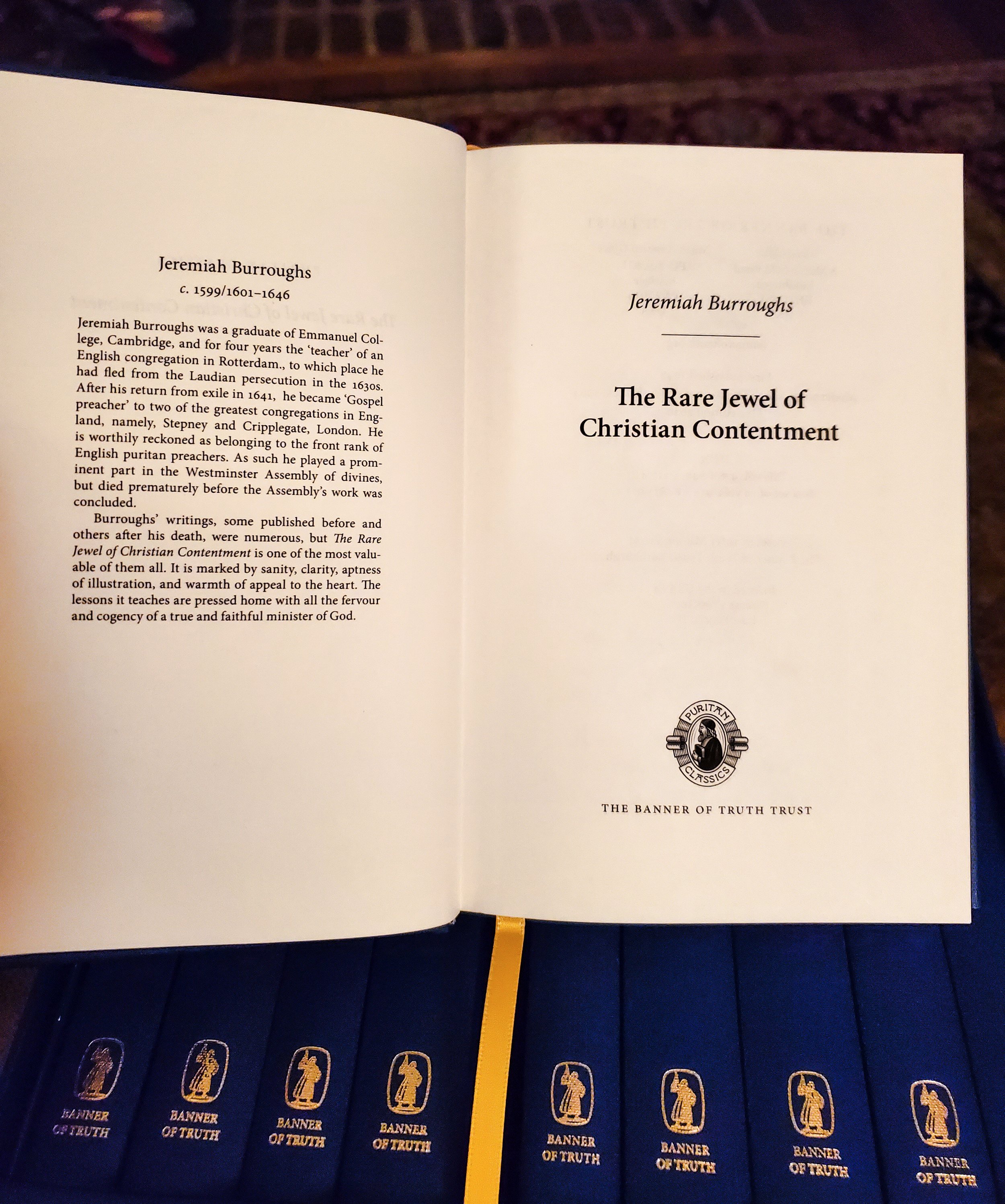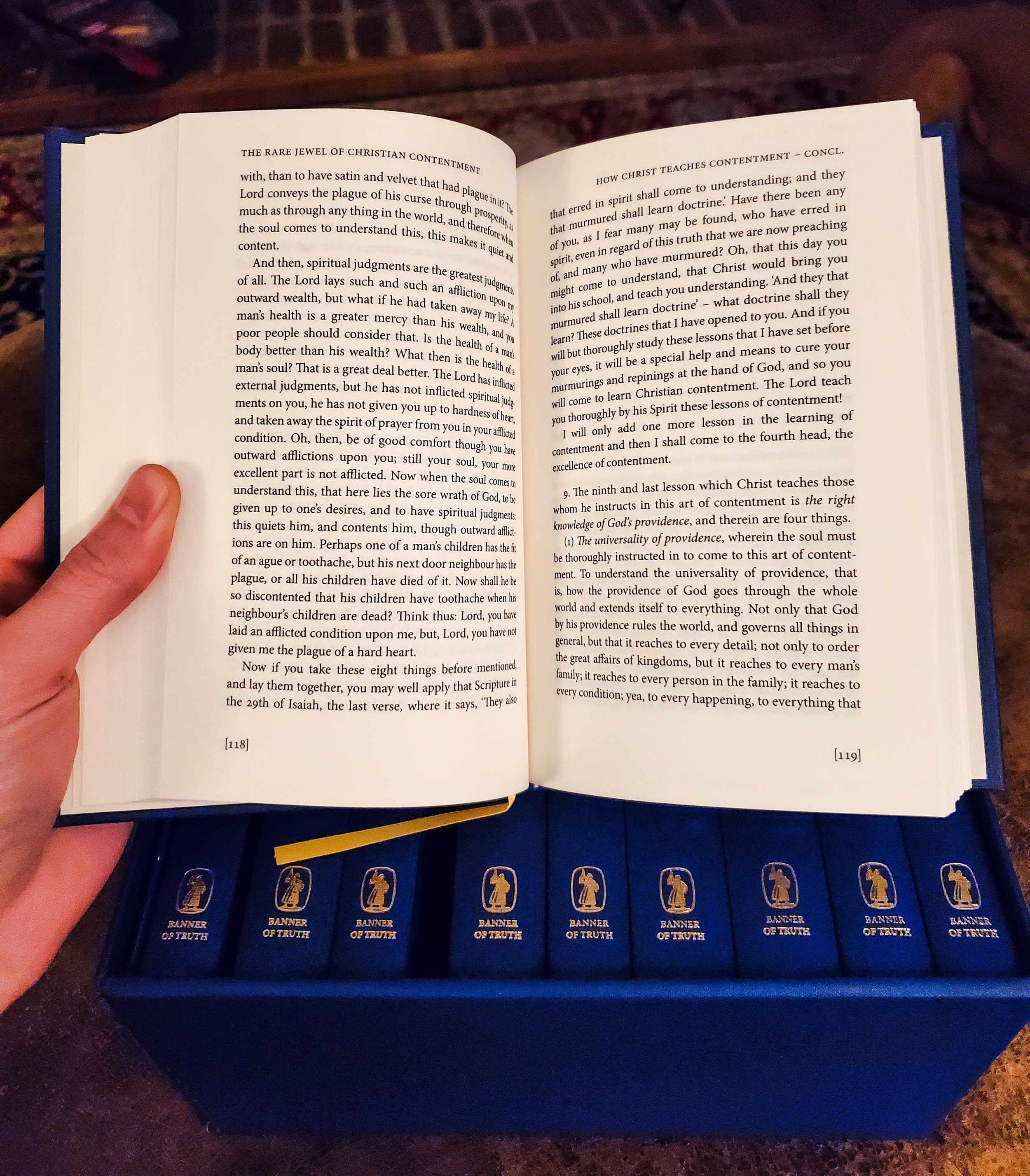Banner of Truth’s Puritan Classic Box Set
A Brief Initial Review
Just released this month (November 2020), the Puritan Classics box set by Banner of Truth is a notable offering that stems out of the well-loved Puritan Paperback collection. Many pastors, like Steven Lawson and Kevin DeYoung, will be the first to tell you the influence these writings, and the collective offerings, have had on their lives. In this review, I’ll go through a quick overview of the presentation, content, and insight on the details of this set—which may wind up being a compare and contrast between the hardbound and paperback editions, for good reasons that you’ll quickly understand.
Let’s dive into the initial appearance out of the gate:
Presentation
This is a 10-lb. box of blue goodness. Coming in at roughly 10″ x 8″ x 5.5″, this is a nice size set for any bookcase, shelf, nook or cranny that you might have. While these are certainly on the compact size of many theology-related book sets you’re likely to have, I think this bodes well for those looking to have a premier set of a sizeable “core” of the shorter Puritan writings Banner offers.
It is very worthwhile to compare the Puritan Paperbacks, physically, to these Puritan Classics. As you can see, these hardbound editions are are very similar in size to their paperback counterparts. I think this makes them attractive for those who appreciate the Puritan Paperback collection in their offering of compact editions, and simultaneously keeps them as a substitute, or alternative, to the paperbacks when it comes to the selected writings included in this new set.
You will certainly not be giving up a significantly larger amount of shelf space with these editions, compared to their paperback counterparts. The page dimensions themselves are nearly identical—the hardbound pages being only a millimeter or two longer than the paperback’s; the only difference in width of the two presentation is, ultimately, the thickness of the bindings and covers.
I’ll get into the text differences momentarily, but the thicknesses—outside of, again, bindings and covers—is related to material and format. I’m not certain of the papers’ gsm difference (paper thickness is measured as a by-product of weight in ‘grams per square meter’), but the new hardbound editions use a thinner paper stock, slightly larger margins, and smaller font (which I’ll get to). The effects are, in Burroughs’ The Rare Jewel of Christian Contentment’ a 273-page hardbound edition vs. a 228-page paperback edition.
Content
Inside the covers, we see even more similarities between the editions, which cements that this Puritan Classics set is, indeed, intended to be an ‘upgrade’ offering to the paperbacks in more than just substance. In keeping so closely with the form of the predecessor set, it doesn’t have any intention to outgrow the originals by much at all, both in size and content.
Taking font size out of the equation, the hardbound and paperback editions (of single works, that is—not in regards to the 5 volumes that include multiple works) are only several pages away from being identical. The new editions include a small bio offering opposite of the title page, but both contain the full biographical information sections just the same. The paperbacks also appear to have advertising info at the end of the book that these hardbound editions forego.
In regards to font, the Puritan Classics are typeset in a 10/13 split of Minion Pro font, whereas the Paperbacks employ 11/15 Sabon Oldstyle. With the aforementioned slight margin differences, this explains in totus the longer page count on the new offerings.
By nature of the fonts, the Paperbacks have a more antique printing look—which I’ve come to love as a by-product of the many works sets and photolithograph editions of old works from the Puritans through Old Princeton theology writings that continue to be offered or exist in earlier form.
The Classics set still retains a traditional font style, but is more modern in the crispness and consistency of the printing itself, lending to a much finer look on higher quality paper. As a result of the narrower, higher clarity font, the line spacing is increased as well. So, words per page is ultimately decreased, while maintaining a high ease of readability. The Paperbacks seem to angle for compactness and classic look, while the new Classics sacrifice both only minimally for a pleasurable page view.
A single gold ribbon is the cherry on top, a simply yet appropriate addition to an already attractive royal blue, cloth-bound presentation.
Insight
Now that we’ve gone through the physical and visual aspects, the last course of action is to run through thoughts on the broader substance of the collective writings themselves.
The Puritan Paperbacks Series is made up of an ever-expanding 57-volumes, the most recent being Brook’s An Ark for All God’s Noahs and Traill’s Select Practical Writings. This Puritan Classics set takes 15 of those particularly renowned writings and puts them in a 10-volume offering. The selections are:
The Art of Prophesying — William Perkins
The Bruised Reed — Richard Sibbes
The Letters of Samuel Rutherford — Samuel Rutherford
The Loveliness of Christ — Samuel Rutherford
A Lifting Up for the Downcast — William Bridge
The Rare Jewel of Christian Contentment — Jeremiah Burroughs
Precious Remedies Against Satan’s Devices — Thomas Brooks
The Reformed Pastor — Richard Baxter
The Godly Man’s Picture Drawn with a Scripture Pencil — Thomas Watson
The Doctrine of Repentance — Thomas Watson
All Things For Good — Thomas Watson
The Mystery of Providence — John Flavel
Facing Grief — John Flavel
A Sure Guide to Heaven — Joseph Alleine
Prayer — John Bunyan
The listed selections truly are a ‘core’ of the shorter Puritan writings that Banner of Truth has produced, if not simply of Puritan writings across the board. Between providence, prayer, prophesy, repentance, grief, and many other theological and practical topics, the diversity and blend within this box set appears to be near ideal. While other titles could certainly merit argument to have been included in the collection, I really can’t imagine many having qualms with the selections included.
A nice, albeit minor, addition to the set is the 32-page introduction booklet by the venerable Sinclair Ferguson. While there are tons of reviews/commentary surely to be out there on the individual works themselves, this brief booklet gives slight biographical information alongside explanatory notes on why the particular selection is included in the set. A small add-on, but certainly not insignificant to the set for the appreciative reader.
Conclusion
It seems to me that this box set, if offered for any significant duration, will wind up being a Banner Classic offering itself. Excellent titles with exceptional variety in a well constructed and presented offering. Even though I have a fair number of these titles in my Banner works sets (if not in Puritan Paperback form), I am excited to enjoy reading in the more compact, easily manageable form of these Classics.
If you’re looking, or even considering, grabbing this new Puritan Classics box set, the time is now. As Banner of Truth often does, this newly released set is currently discounted for a limited time (through year end, Dec. 31, 2020, from Banner direct, at least). To learn more or purchase, below are links to sellers that I personally recommend, along with their current prices:
Banner of Truth – $200 + free shipping
Reformation Heritage Books – $180 + free shipping
Cumberland Valley Bible Book Service – $172.50 + 3.99 shipping
Westminster Bookstore – $187.50 + free shipping
Simply ordering this box set alone, you can go with the cheapest offering, but also take a look at the other specials some of these sellers currently have going on. Banner is in the middle of a large sale, some titles and sets that cannot be had elsewhere for nearly the same price, so you may want to take advantage of it while you’re at it!
For those who already know they’ll love this Puritan Classics box set and don’t have John Owen’s 16-volume set or many of his Puritan Paperback offerings, you may want to consider the sister set to Classic set— Treasures of John Owen Box Set , released concurrently in as a green counterpart. Owen’s long list of offerings made it, acceptably, necessary to branch out his collection separately (and I don’t blame them). It also is on newly released discounted pricing for a limited time.







